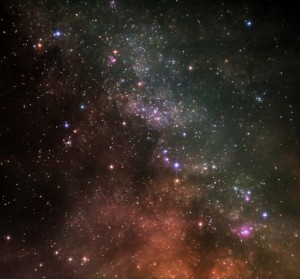From Cosmos to Creation (Article 13)
By Nir Menussi: April 8, 2011: Category Inspirations, Networks of Meaning
Integrating Science and Mysticism (The Kabbalistic Multiverse, Part 2)
 In the previous article we introduced the Kabbalistic “four worlds” model, and claimed it could also be seen as referring to four complementary interpretations of the world. We called this the Kabbalistic Multiverse, and went over its four components – the world (views) of Emanation, Creation, Formation and Action. We also briefly mentioned that the world of Action is strongly analogous to the scientific worldview.
In the previous article we introduced the Kabbalistic “four worlds” model, and claimed it could also be seen as referring to four complementary interpretations of the world. We called this the Kabbalistic Multiverse, and went over its four components – the world (views) of Emanation, Creation, Formation and Action. We also briefly mentioned that the world of Action is strongly analogous to the scientific worldview.
Before proceeding to examining how the Kabbalistic Multiverse could assist us in integrating science and Torah, let’s first have a go at trying to place just the history of science within its context. As we shall see, this will come in handy later on.
Greek Cosmology
Ancient science was born in ancient Greece. Starting in the sixth century BCE the Greek mind gradually awoke from its mythological and magical mindset to develop philosophical abstraction. Part of the emergent philosophy was a rudimentary form of natural science: several models of how the celestial bodies are arranged were suggested; the mineral, vegetable and animal kingdoms were beginning to be classified into species; human anatomy was being explored; systematic medicine was being developed; and so on. This science, most famously summed up in the writings of Aristotle, is widely considered the precursor of modern empirical science, and has placed the foundations for many of its research fields.
Were we to classify the ancient Greek scientific worldview within the Kabbalistic Multiverse, under which ‘world’ should we place it? Without a doubt, the world most fitting to it would be the world of Formation.
Ancient Greek science was not very empirical in nature, at least not in the strict sense we’re accustomed to today. It certainly observed nature and collected data (it had very good records of the movement of the planets, for example, which it inherited from the Babylonians and expanded); nonetheless, it did not formulate its theories based on much meticulous and accurate observation. Its theories grew primarily out of intuition: it had an innate aesthetic predilection to particular harmonious structures, which it would then look for in nature, many times bending the data to make it fit the theory.
For example, the Greeks found perfection in the shape of a circle, and so tried to explain the apparently unstructured movement of the planets solely in terms of circular movements (by positing spheres upon spheres and circles upon circles, they actually managed to do so quite brilliantly). They had a fondness for grids, and so explained matter as made up of four elements which fit into a two by two table of qualities (earth: cool and dry; air: hot and moist; etc.). They loved the mathematical relation known as the Golden Section, and so looked for it, and found it, in the proportions of different organs in the human body. And so on.
In other words, Greek science assumed nature is ordered according to certain ideal forms, and then started looking for them. This is why they named the universe Cosmos, which literally means ‘harmonic order’. All this is a clear sign of a mindset originating in the world of Formation.
Christian Creationism
With the dawn of the Middle Ages, the Greek worldview was supplanted by that of Christianity. While Christianity adopted Aristotelian science and Christian scholars were well versed in it, it barely developed it further, and science ended up stagnating quite a bit. However, Christianity did add a crucial element to the Greek worldview, taken from the Hebrew Bible, which changed it radically: it placed a Divine Creator behind it, who created the world out of nothing, continuously supervised its progress, heard and related to its inhabitants, and intervened in its course.
Now, Greek science did have a notion of a God in charge of the cosmos, referred to in the writings of Plato (the “demiurgus”), Aristotle (the “unmoved mover”) and others; but this was an impersonal God which really stood for the logos—the supernal rational mind behind the cosmic order. He wasn’t a beneficial and deliberate creator who chose to create the world, cared about its inhabitants or was able to change it. Furthermore, in Greek cosmology, the universe had existed forever, with no starting point in time. It was as everlasting as the God behind it, and thus in many ways his equal. Both these elements entered the Western mind only with the rise of Christianity.
In the Kabbalistic Multiverse terminology, when Christianity added the Biblical Creator of the world to the Greek cosmology, it thereby expanded it ‘upwards’, turning it from a worldview based solely on a Formation mindset, to a worldview containing also, and primarily, the vantage point of Creation. No longer just an orderly Cosmos with which man is to harmonize, it became a Creation—a purposefully built moral arena which man, made in the image of his Creator, must transcend in order to reach Him.
 For over a thousand years this worldview flourished without changing. It was somewhere in the sixteenth century that the third chapter of science’s history began, which was to shake it to its foundations and rebuild it from based on an entirely new point of view. The chapter was titled empirical science, and it was through the lens of the neglected world of Action that it began, for the first time in Western history, to explore reality.
For over a thousand years this worldview flourished without changing. It was somewhere in the sixteenth century that the third chapter of science’s history began, which was to shake it to its foundations and rebuild it from based on an entirely new point of view. The chapter was titled empirical science, and it was through the lens of the neglected world of Action that it began, for the first time in Western history, to explore reality.
http://www.interinclusion.org/inspirations/from-creation-to-universe-article-14/
From Cosmos to Creation (Article 13) ,

















;)
;)
;)
;)
;)
;)
;)
;)
;)
;)
